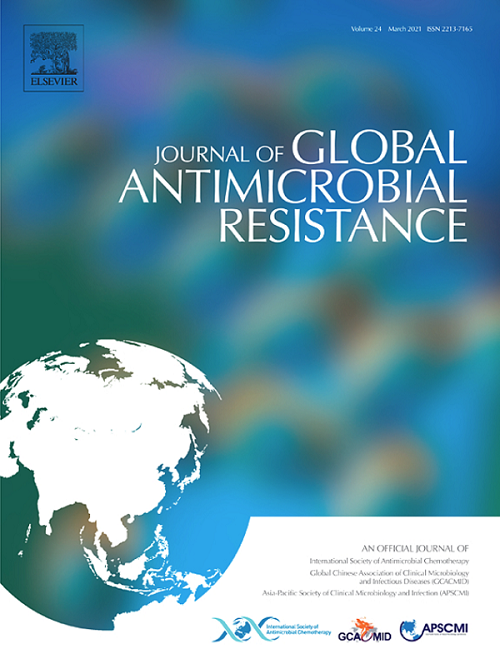来自母亲及其新生儿的碳青霉烯抗性肠杆菌的基因组相似性。
IF 3.2
3区 医学
Q2 INFECTIOUS DISEASES
引用次数: 0
摘要
目的:新德里金属β-内酰胺酶是印度特有的,肠道可能作为产碳青霉烯酶肠杆菌(cpe)的储存库。含有blandm的CPE的母体肠道定植增加了新生儿肠道定植的风险。本研究旨在评估CPE从孕妇(直肠)到新生儿(直肠和血液)的垂直传播。方法:收集直肠标本进行cpe检测,并进行细菌鉴定和药敏试验。采用脉冲场凝胶电泳(PFGE)和全基因组测序(WGS)来检测同种定植的母幼对的遗传亲缘关系。检测blandm变异及其传播率。结果:86例孕妇和93例患病新生儿中,8对母婴携带相似的碳青霉烯类耐药菌,以肺炎克雷伯菌为主,其次为大肠杆菌。PFGE和WGS结果显示,大多数母子对分离株具有明显的差异,分布在不同的序列类型中,包括流行克隆(ST11/15/147/405/410)。在CPE中检测到blaNDM-1/5/7,主要与接合的IncFII和IncFII(K)复制子相关。基因组分析支持1例垂直传播(ST147;blaNDM-1 + ve-K。肺炎)从母亲传染给新生儿。需要进一步研究外源以了解细菌的获得。没有证据表明携带blandm的质粒在携带不同分离株的母婴对中传播,这表明细菌是独立获得的。结论:尽管本研究中观察到的母婴传播证据有限,但肠道筛查对于了解医院内外CPE传播是必要的。需要有针对性的监测和感染预防政策来遏制CPE的传播。本文章由计算机程序翻译,如有差异,请以英文原文为准。
Genomic similarity of carbapenem-resistant Enterobacterales collected from mothers and their neonates
Objective
New Delhi metallo-β-lactamase is endemic in India and the gut may act as a reservoir of carbapenemase-producing Enterobacterales (CPE). Maternal gut colonisation with blaNDM-harbouring CPE increases the risk of neonatal gut colonisation. This study aimed to assess the vertical transmission of CPE from pregnant mothers (rectal) to neonates (rectal and blood).
Methods
Rectal samples were collected and processed for the presence of CPE, followed by bacterial identification and antibiotic susceptibility. Mother–neonate pairs colonised with the same species underwent pulsed-field gel electrophoresis and whole-genome sequencing to examine genetic relatedness. Detection of blaNDM variants and their transmissibility was performed.
Results
Of the pregnant mothers (n = 86) and sick neonates (n = 93) analysed, eight mother–neonate pairs harboured similar carbapenem-resistant species, predominantly Klebsiella pneumoniae, followed by Escherichia coli. Pulsed-field gel electrophoresis and whole-genome sequencing revealed that most isolates from mother–neonate pairs were distinct and distributed within diverse sequence types, including epidemic clones (ST11/15/147/405/410). blaNDM-1/5/7 were detected in CPE and predominantly associated with conjugative IncFII and IncFII(K) replicons. Genomic analysis supported one case of vertical transmission (ST147; blaNDM-1-positive K. pneumoniae) from mother to a neonate. Further investigation of exogenous sources is required to understand the acquisition of bacteria. No evidence of transmission of blaNDM-harbouring plasmids within mother–neonate pairs carrying distinct isolates was observed, indicating the independent acquisition of bacteria.
Conclusions
Although limited evidence of mother-to-neonate transmission was observed in this study, screening of the gut is necessary to understand CPE transmission in hospital settings and beyond. Targeted surveillance and infection-prevention policies are needed to curb CPE spread.
求助全文
通过发布文献求助,成功后即可免费获取论文全文。
去求助
来源期刊

Journal of global antimicrobial resistance
INFECTIOUS DISEASES-PHARMACOLOGY & PHARMACY
CiteScore
8.70
自引率
2.20%
发文量
285
审稿时长
34 weeks
期刊介绍:
The Journal of Global Antimicrobial Resistance (JGAR) is a quarterly online journal run by an international Editorial Board that focuses on the global spread of antibiotic-resistant microbes.
JGAR is a dedicated journal for all professionals working in research, health care, the environment and animal infection control, aiming to track the resistance threat worldwide and provides a single voice devoted to antimicrobial resistance (AMR).
Featuring peer-reviewed and up to date research articles, reviews, short notes and hot topics JGAR covers the key topics related to antibacterial, antiviral, antifungal and antiparasitic resistance.
 求助内容:
求助内容: 应助结果提醒方式:
应助结果提醒方式:


